PBW Stories
Paperback Writer's Fiction BlogSaturday, February 14, 2009
Basic Patchwork Quilt Repair
Repairing a quilt mainly requires time and patience. Before you attempt to repair any vintage quilt, it's a good idea to have it appraised and (if possible) obtain an estimate on having it restored by a professional, certified quilt conservator. Because most vintage quilts are in fragile condition, and are unique pieces of history that cannot be replaced, you may do more harm than good by trying to repair it yourself.
Still, if you own a relatively newer quilt that needs some TLC, or you buy an old or cutter quilt that isn't valuable but that you'd like to repair, you can perform basic repairs yourself. First, be sure the quilt is basically strong enough for regular use or display, because there's no sense in repairing a quilt you can't use.
You'll also need to figure out how much work is going to be involved. Estimate the amount of damage you have to repair by looking at the surface of the piece. I never work a quilt that is more than 50% damaged because it's too time-consuming; I can make three or four brand-new quilts in the same amount of time it takes to repair a seriously damaged piece.
Here's a section of an antique quilt I'm working on this week. It's approximately twenty to thirty years old, probably one of the early imports that were sold in department stores when the quilt craze started taking off:

I don't care for imported quilts, which are made in sweat shops overseas by women who are only paid pennies for their work, but since they have little to no value they're excellent to use as teaching and demonstration pieces. I also like reclaiming imported quilts and transforming them because that's my little way of flipping off the department stores (this project will be part of a booklet I'm writing for my guild.)
The foundation of this quilt is intact and strong, the machine quilting is also in great shape, and the feel of it is nice and soft. Most of the dresden plates (the circles of patchwork) are worn and/or torn. To repair it, I'll have to replace each patch one at a time.
Each conservator has a slightly different approach to repair work. I custom-fit my replacement patches to the individual area because over time quilts stretch and what may have started out as a piece with identical-sized patches will have variations in patch size.
To custom-fit patchwork, the first step is to measure the dimensions of the patch you want to replace:

Use a piece of your scrap/leftover fabric or cut a patch from new fabric that is at least 1/2" wider and longer than the patch you're replacing:
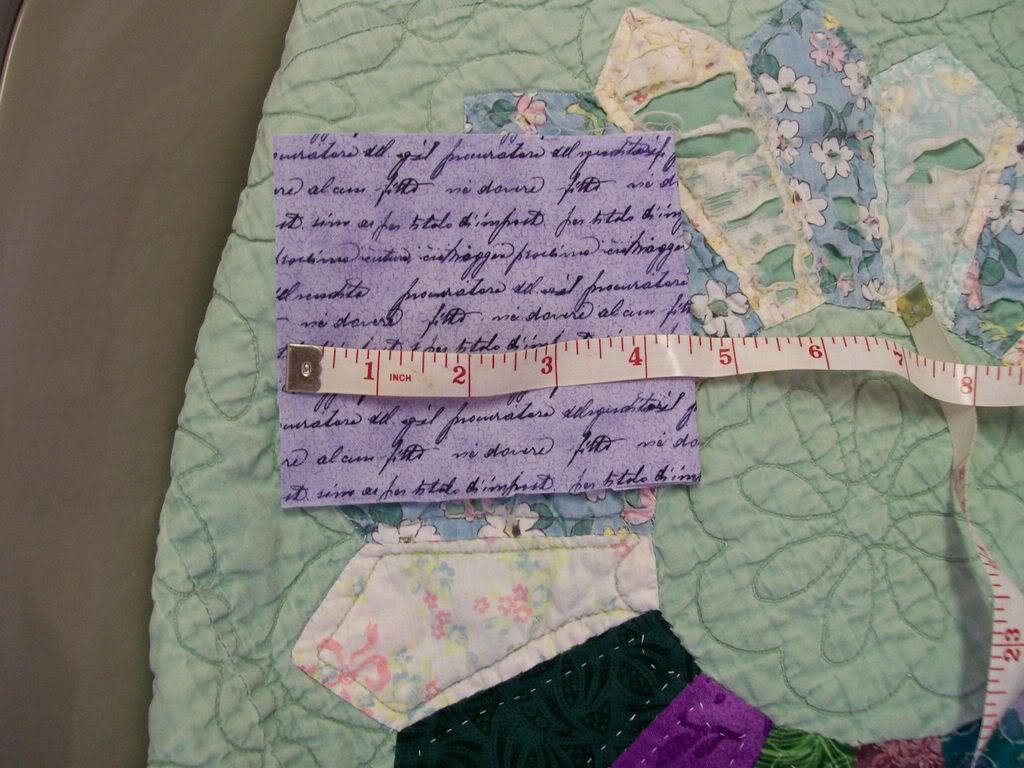
Fold under 1/4" of one side of the patch (I generally start at the longest/bottom-most seam) and pin it in place directly over the old patchwork:

Now working in a counter-clockwise direction, move to the next seam and fold your new patch backward until the edge matches the corresponding seam of the old patch. Trim to 1/4", then fold under the extra fabric and pin in place:
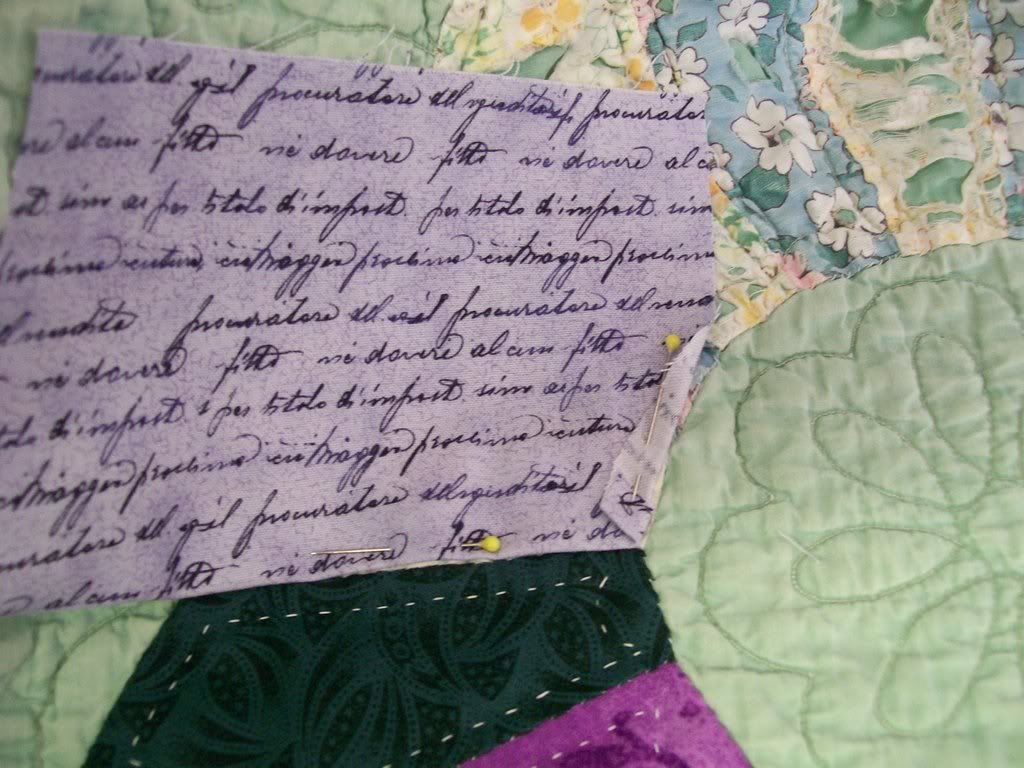
Repeat this step with the next side of the patch:

Remember to trim only to 1/4" of the seam, to give you enough fabric to fold under and pin:

Continue in a counter-clockwise direction, repeating the same steps:
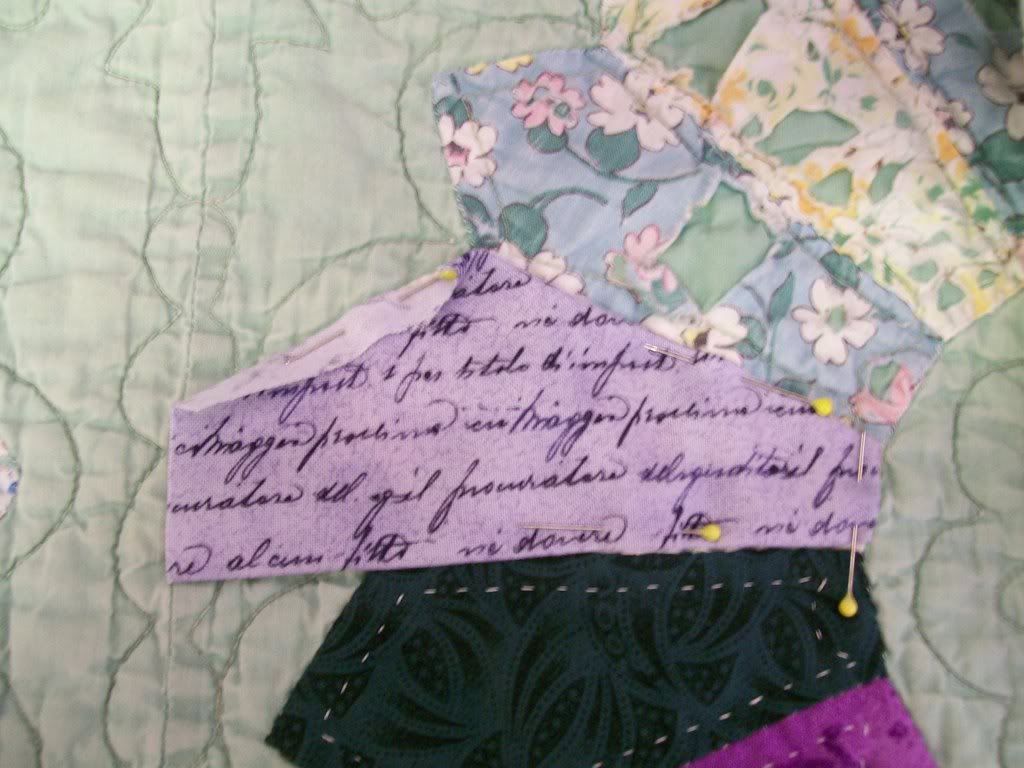
When you have fitted your new patch to the quilt, it should look like this:
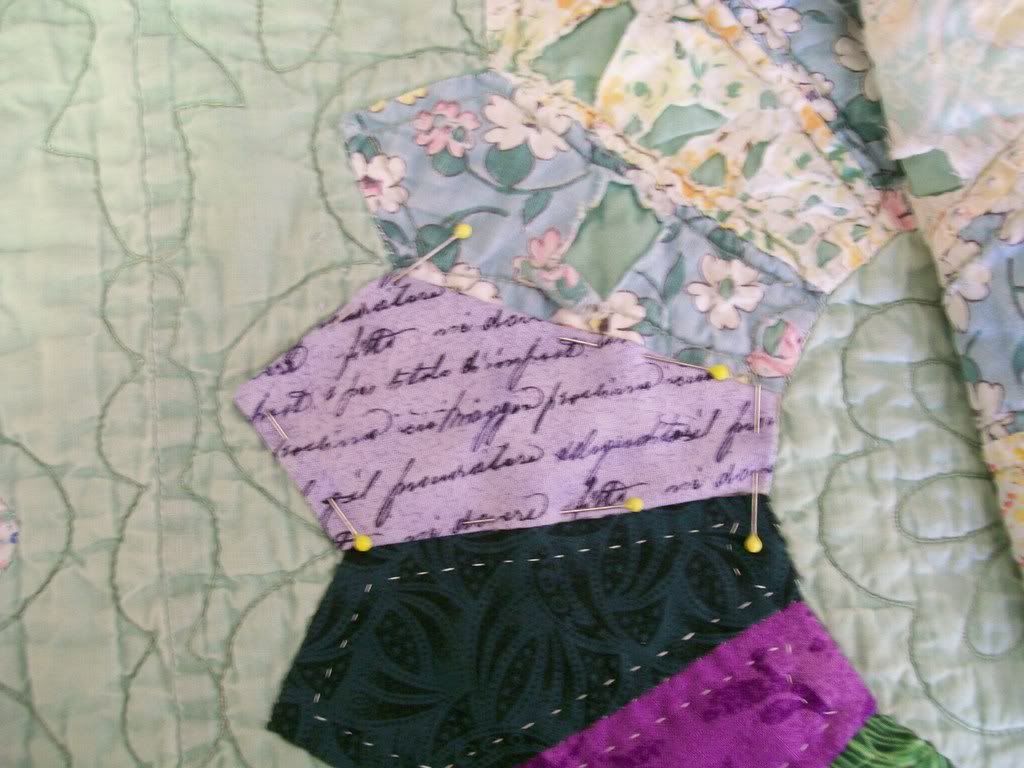
Starting at the innermost seam, begin blind-stitching or applique-stitching your new patch to the old (I use a blind stitch because I think it looks neater.) Your new seams should just cover the old ones beneath it:
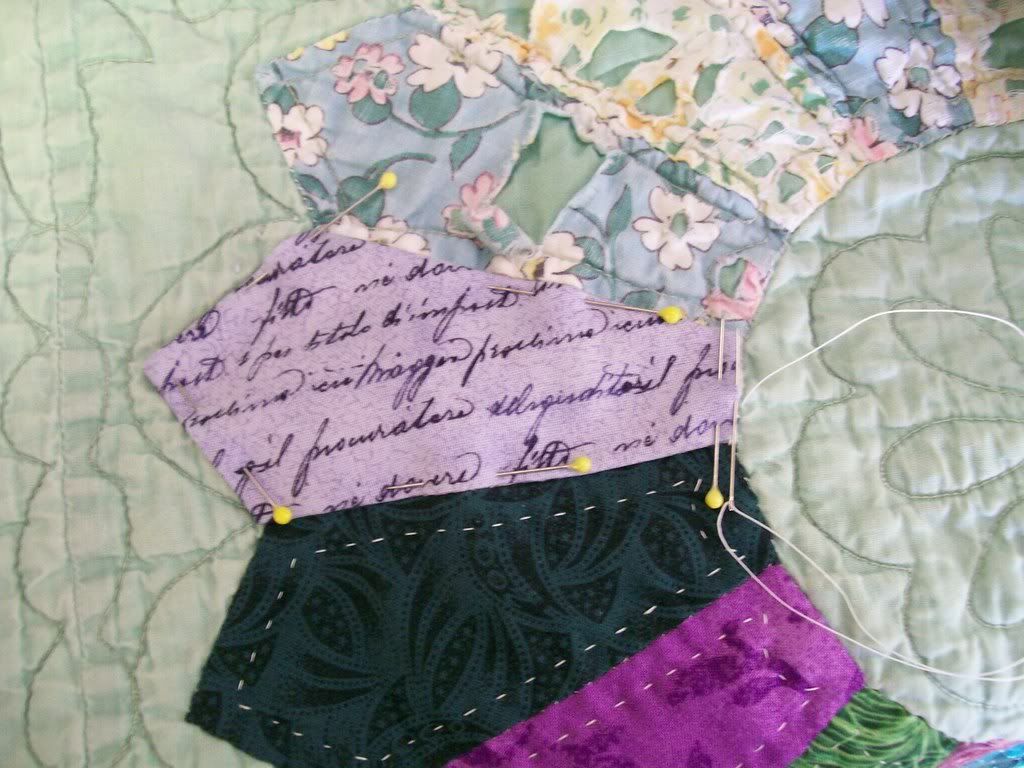
Continue stitching the patch to the surface of quilt in a counter-clockwise direction until all of the seams are sewn over the old patch:
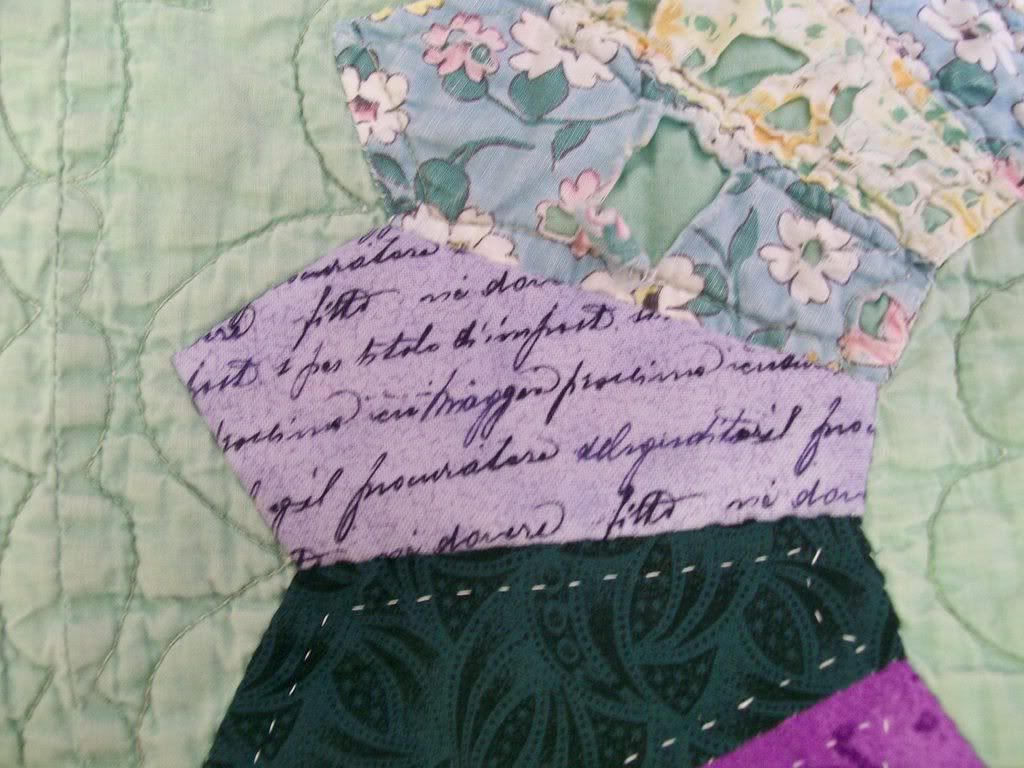
Once you've stitched the replacement patch in place, you can quilt it to the quilt. Your stitched will likely be larger than usual because you have to get the needle through an extra layer of material:
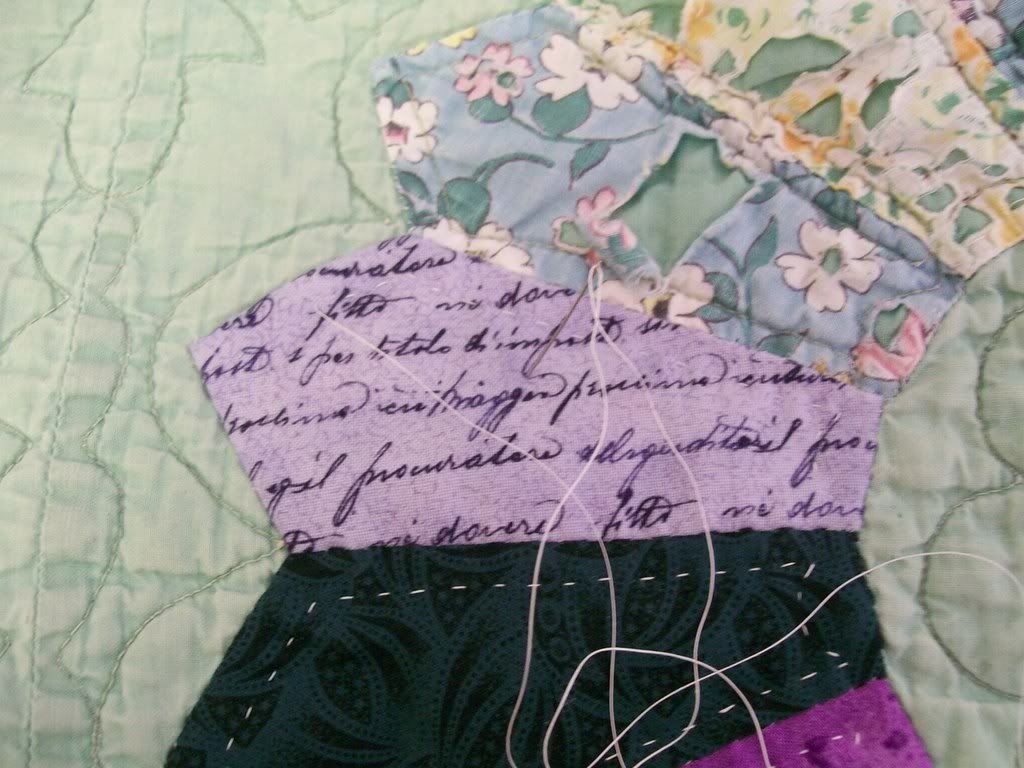
The finished patch should look like this:

Here's the progress I've made so far on this section:

This technique not only repairs the damage, it preserves the original patchwork beneath the replacement fabric. This adds strength to the quilt but more importantly it preserves the original work. While imports may never have any value, I don't like destroying someone else's work -- and who knows, maybe in thirty more years old import quilts will skyrocket in value.
Another note on this particular project: Usually I would use fabrics that match the surface patchwork, but because this contains cheap, uninteresting materials without much variety in the patterns I decided it wasn't worth going through the effort of fabric matching. Making it over with these stronger, more dramatic colors and patterns will give it more contrast and visual impact, and will draw the eye away from some of the sunlight damage to the background fabric.
The work to properly repair a quilt is painstaking and can get boring, so I recommend anyone who hasn't ever tried it to start with something small. Practice first on a cutter quilt piece (a manageable section cut out of an old quilt; you can buy them on eBay) or a crib-size baby quilt.
Also, don't attempt to make your first repair job a quilt with small or difficult-looking patchwork pattern; go for simple quilts that have block- or rectangular patchwork (triangle-shaped patches are hard to fold and fit; circular or curved patchwork requires a different type of fitting technique for replacement patches.)
Added 2/17/09: Here's a before and after on the finished section:
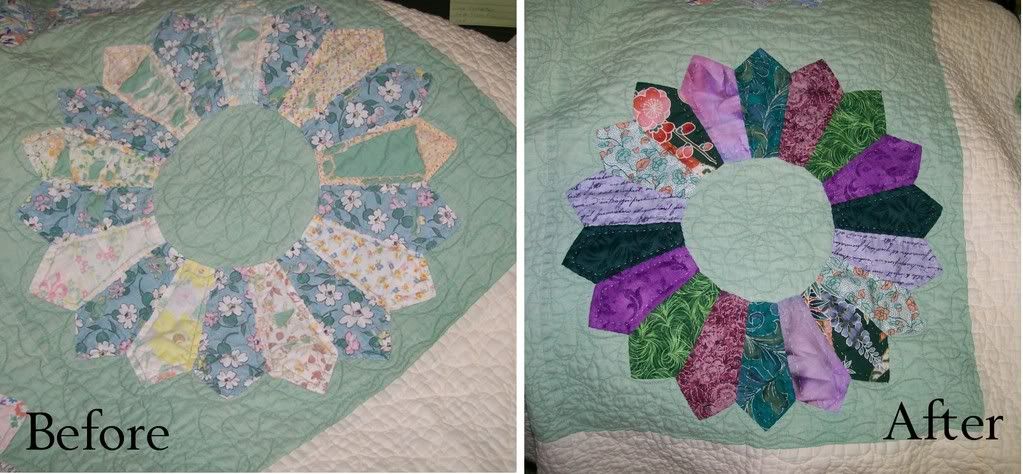
Repairing a quilt mainly requires time and patience. Before you attempt to repair any vintage quilt, it's a good idea to have it appraised and (if possible) obtain an estimate on having it restored by a professional, certified quilt conservator. Because most vintage quilts are in fragile condition, and are unique pieces of history that cannot be replaced, you may do more harm than good by trying to repair it yourself.
Still, if you own a relatively newer quilt that needs some TLC, or you buy an old or cutter quilt that isn't valuable but that you'd like to repair, you can perform basic repairs yourself. First, be sure the quilt is basically strong enough for regular use or display, because there's no sense in repairing a quilt you can't use.
You'll also need to figure out how much work is going to be involved. Estimate the amount of damage you have to repair by looking at the surface of the piece. I never work a quilt that is more than 50% damaged because it's too time-consuming; I can make three or four brand-new quilts in the same amount of time it takes to repair a seriously damaged piece.
Here's a section of an antique quilt I'm working on this week. It's approximately twenty to thirty years old, probably one of the early imports that were sold in department stores when the quilt craze started taking off:

I don't care for imported quilts, which are made in sweat shops overseas by women who are only paid pennies for their work, but since they have little to no value they're excellent to use as teaching and demonstration pieces. I also like reclaiming imported quilts and transforming them because that's my little way of flipping off the department stores (this project will be part of a booklet I'm writing for my guild.)
The foundation of this quilt is intact and strong, the machine quilting is also in great shape, and the feel of it is nice and soft. Most of the dresden plates (the circles of patchwork) are worn and/or torn. To repair it, I'll have to replace each patch one at a time.
Each conservator has a slightly different approach to repair work. I custom-fit my replacement patches to the individual area because over time quilts stretch and what may have started out as a piece with identical-sized patches will have variations in patch size.
To custom-fit patchwork, the first step is to measure the dimensions of the patch you want to replace:

Use a piece of your scrap/leftover fabric or cut a patch from new fabric that is at least 1/2" wider and longer than the patch you're replacing:

Fold under 1/4" of one side of the patch (I generally start at the longest/bottom-most seam) and pin it in place directly over the old patchwork:

Now working in a counter-clockwise direction, move to the next seam and fold your new patch backward until the edge matches the corresponding seam of the old patch. Trim to 1/4", then fold under the extra fabric and pin in place:

Repeat this step with the next side of the patch:

Remember to trim only to 1/4" of the seam, to give you enough fabric to fold under and pin:

Continue in a counter-clockwise direction, repeating the same steps:

When you have fitted your new patch to the quilt, it should look like this:

Starting at the innermost seam, begin blind-stitching or applique-stitching your new patch to the old (I use a blind stitch because I think it looks neater.) Your new seams should just cover the old ones beneath it:

Continue stitching the patch to the surface of quilt in a counter-clockwise direction until all of the seams are sewn over the old patch:

Once you've stitched the replacement patch in place, you can quilt it to the quilt. Your stitched will likely be larger than usual because you have to get the needle through an extra layer of material:

The finished patch should look like this:

Here's the progress I've made so far on this section:

This technique not only repairs the damage, it preserves the original patchwork beneath the replacement fabric. This adds strength to the quilt but more importantly it preserves the original work. While imports may never have any value, I don't like destroying someone else's work -- and who knows, maybe in thirty more years old import quilts will skyrocket in value.
Another note on this particular project: Usually I would use fabrics that match the surface patchwork, but because this contains cheap, uninteresting materials without much variety in the patterns I decided it wasn't worth going through the effort of fabric matching. Making it over with these stronger, more dramatic colors and patterns will give it more contrast and visual impact, and will draw the eye away from some of the sunlight damage to the background fabric.
The work to properly repair a quilt is painstaking and can get boring, so I recommend anyone who hasn't ever tried it to start with something small. Practice first on a cutter quilt piece (a manageable section cut out of an old quilt; you can buy them on eBay) or a crib-size baby quilt.
Also, don't attempt to make your first repair job a quilt with small or difficult-looking patchwork pattern; go for simple quilts that have block- or rectangular patchwork (triangle-shaped patches are hard to fold and fit; circular or curved patchwork requires a different type of fitting technique for replacement patches.)
Added 2/17/09: Here's a before and after on the finished section:

Labels: quilting
Saturday, February 07, 2009
An excerpt from Shadowlight
A novel of the Kyndred
by Lynn Viehl
to be published November 2009
Lucan noticed three things about the state of Georgia: the land was beautiful, the natives’ dialect made them almost as incomprehensible as the Cubans of south Florida, and the men in authority here did not care for females having the same.
“That there’s the problem, Miss,” the fat desk sergeant said as he settled his bulk on one elbow so he could get a better view of Samantha’s neckline. “Y’all come here without an invite to pick up a prisoner after hours. I don’t know how y’all run your department down there, but that’s not how it works in Atlanta.”
Much to Lucan’s disappointment, Samantha did not leap across the scarred surface of the reception desk or rip out the offensive mortal’s throat. She, the soul of patience, merely smiled.
“The prisoner has considerable financial resources at his command and is a serious flight risk,” she told the insolent mortal. “The last time he made bail on capital murder charges, he fled the state. The district attorney wants only to assure that he stands trial in Fort Lauderdale.”
“Lady, my captain don’t care if he has to go before a judge in the North Pole.” He chuckled at his own joke. “We got our way of doing things, and this ain’t it.”
“Obviously.” Lucan took her elbow and pulled her to one side. “This is a waste of time. I will go and retrieve the bag of scum.”
“Scumbag,” she corrected. “We had an agreement. We’re here to extradite Grodan, not terrorize and destroy half the city.” Before he could reply, she added, “Behave yourself, Suzerain, or I’ll make you fill out the paperwork.”
He eyed the stack of forms the desk sergeant had produced. “You would not be so heartless.”
“Keep pushing and find out.” She went back to the desk, collected the forms, and made an appointment to see the chief of homicide the following afternoon. “Would it be possible to obtain a copy of the arrest reports?” When the man scowled, she added, “I have to call the district attorney tonight, and I’m sure he’d be interested in how cooperative your department has been.”
The sergeant released a long suffering sigh before he trudged into a back office and returned a few minutes later. “Here’s copies of what all the Feds sent over with him.”
“Thank you.” Sam took the folder and glanced at Lucan. “We’ll need a hotel room.”
“Five of my favorite words.” He clasped her hand in his. “But I’ve already arranged suitable accommodations.”
She didn’t seem to hear him, engrossed as she was in the contents of the file. In the car, she finished reading and closed the folder. “That’s odd. I thought they caught him in the act, but they didn’t even know he was in the city. Stop driving so fast.”
“This is a Ferrari,” he reminded her. “It does not allow itself to be driven slowly. What act?”
“Setting up another con,” Samantha said. “The guy uses his partners for everything – making hotel registrations, renting cars, buying whatever he needs – all under their names. That way there’s never any evidence implicating him. He never leaves a trail. I figured his new partner tipped off the Bureau. Instead, they get an anonymous phone call reporting him and the partner.”
Lucan shrugged. “So a good citizen did their duty. Mortals are forever blowing the horn on each other.”
“The whistle, not the horn. This someone knew everything – where he was, who he was with, what they’d already done in New York and what they planned to do here. Max is a ghost. He just doesn’t exist.” She frowned, thinking. “Maybe one of his old partners got away from him. But how would she know where he was, and what he doing?”
A novel of the Kyndred
by Lynn Viehl
to be published November 2009
Lucan noticed three things about the state of Georgia: the land was beautiful, the natives’ dialect made them almost as incomprehensible as the Cubans of south Florida, and the men in authority here did not care for females having the same.
“That there’s the problem, Miss,” the fat desk sergeant said as he settled his bulk on one elbow so he could get a better view of Samantha’s neckline. “Y’all come here without an invite to pick up a prisoner after hours. I don’t know how y’all run your department down there, but that’s not how it works in Atlanta.”
Much to Lucan’s disappointment, Samantha did not leap across the scarred surface of the reception desk or rip out the offensive mortal’s throat. She, the soul of patience, merely smiled.
“The prisoner has considerable financial resources at his command and is a serious flight risk,” she told the insolent mortal. “The last time he made bail on capital murder charges, he fled the state. The district attorney wants only to assure that he stands trial in Fort Lauderdale.”
“Lady, my captain don’t care if he has to go before a judge in the North Pole.” He chuckled at his own joke. “We got our way of doing things, and this ain’t it.”
“Obviously.” Lucan took her elbow and pulled her to one side. “This is a waste of time. I will go and retrieve the bag of scum.”
“Scumbag,” she corrected. “We had an agreement. We’re here to extradite Grodan, not terrorize and destroy half the city.” Before he could reply, she added, “Behave yourself, Suzerain, or I’ll make you fill out the paperwork.”
He eyed the stack of forms the desk sergeant had produced. “You would not be so heartless.”
“Keep pushing and find out.” She went back to the desk, collected the forms, and made an appointment to see the chief of homicide the following afternoon. “Would it be possible to obtain a copy of the arrest reports?” When the man scowled, she added, “I have to call the district attorney tonight, and I’m sure he’d be interested in how cooperative your department has been.”
The sergeant released a long suffering sigh before he trudged into a back office and returned a few minutes later. “Here’s copies of what all the Feds sent over with him.”
“Thank you.” Sam took the folder and glanced at Lucan. “We’ll need a hotel room.”
“Five of my favorite words.” He clasped her hand in his. “But I’ve already arranged suitable accommodations.”
She didn’t seem to hear him, engrossed as she was in the contents of the file. In the car, she finished reading and closed the folder. “That’s odd. I thought they caught him in the act, but they didn’t even know he was in the city. Stop driving so fast.”
“This is a Ferrari,” he reminded her. “It does not allow itself to be driven slowly. What act?”
“Setting up another con,” Samantha said. “The guy uses his partners for everything – making hotel registrations, renting cars, buying whatever he needs – all under their names. That way there’s never any evidence implicating him. He never leaves a trail. I figured his new partner tipped off the Bureau. Instead, they get an anonymous phone call reporting him and the partner.”
Lucan shrugged. “So a good citizen did their duty. Mortals are forever blowing the horn on each other.”
“The whistle, not the horn. This someone knew everything – where he was, who he was with, what they’d already done in New York and what they planned to do here. Max is a ghost. He just doesn’t exist.” She frowned, thinking. “Maybe one of his old partners got away from him. But how would she know where he was, and what he doing?”
Labels: Darkyn, excerpt, Shadowlight
Archives
May 2006 July 2006 September 2006 October 2006 March 2007 June 2007 August 2007 November 2007 December 2007 March 2008 May 2008 October 2008 November 2008 February 2009 April 2009 June 2009 October 2009 November 2009 January 2010 February 2010 October 2010 November 2010 March 2011 June 2011 August 2012 November 2012 November 2014